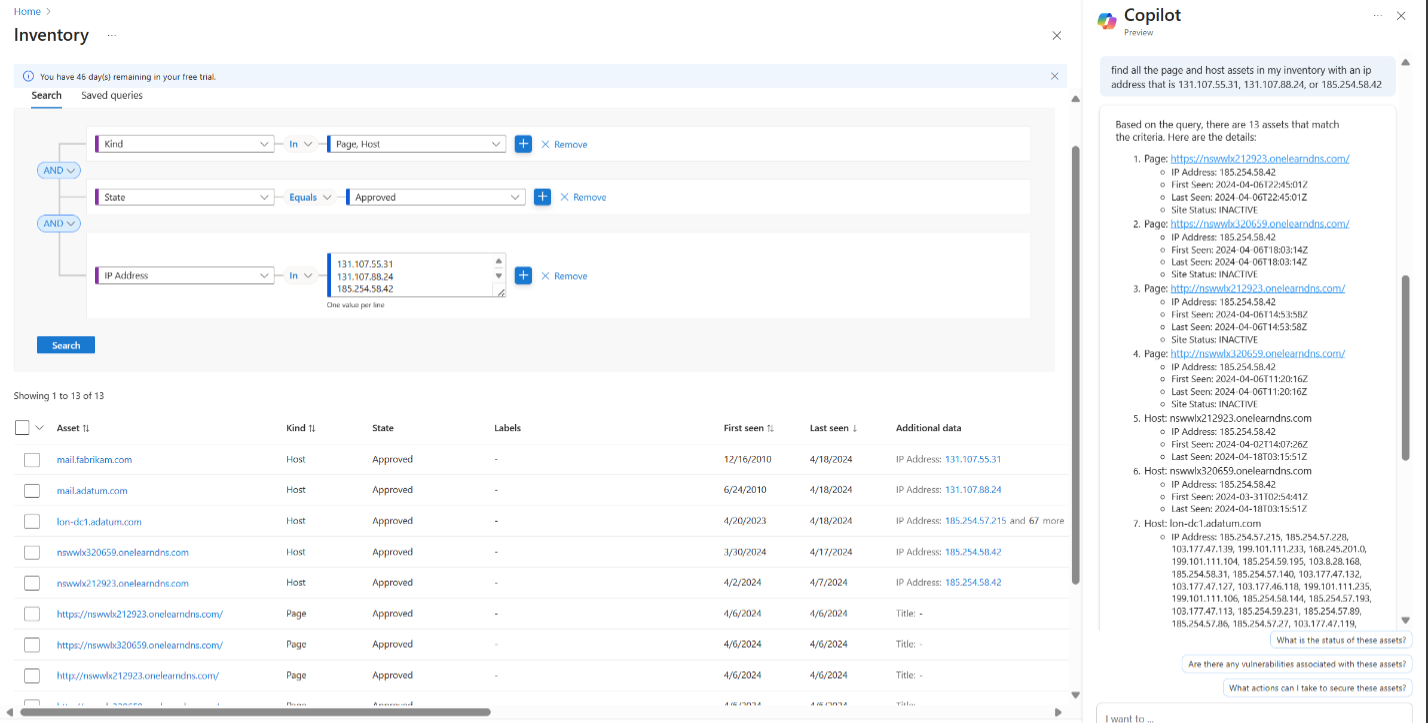Query your attack surface with Defender EASM using Microsoft Copilot in Azure
Microsoft Defender External Attack Surface Management (Defender EASM) scans inventory assets and collects robust contextual metadata that powers Attack Surface Insights. These insights help an organization understand what their attack surface looks like, where the risk resides, and what assets they need to focus on.
Important
Use of Copilot in Azure to query Defender EASM is included with Copilot for Security and requires security compute units (SCUs). You can provision SCUs and increase or decrease them at any time. For more information on SCUs, see Get started with Microsoft Copilot and Manage usage of security compute units.
To use Copilot in Azure to query Defender EASM, you or your admin team must be a member of the appropriate role in Copilot for Security and must have access to a Defender EASM resource. For information on supported roles, see Understand authentication in Microsoft Copilot for Security.
With Microsoft Copilot in Azure (preview), you can use natural language to ask questions and better understand your organization's attack surface. Through Defender EASM's extensive querying capabilities, you can extract asset metadata and key asset information, even if you don't have an advanced Defender EASM querying skillset.
When you ask Microsoft Copilot in Azure about your attack surface, it automatically pulls context when possible, based on the current conversation or on the page you're viewing in the Azure portal. If the context isn't clear, you'll be prompted to specify which Defender EASM resource to use.
Note
The tasks and sample prompts listed here show a few of the areas where Microsoft Copilot in Azure (preview) can be especially helpful. However, this is not a complete list of all the things you can do. We encourage you to experiment with your own prompts and see how Microsoft Copilot in Azure (preview) can help you manage your Azure resources and environment.
Important
Microsoft Copilot in Azure (preview) is currently in PREVIEW. See the Supplemental Terms of Use for Microsoft Azure Previews for legal terms that apply to Azure features that are in beta, preview, or otherwise not yet released into general availability.
Sample prompts
Here are a few examples of the kinds of prompts you can use to query attack surface data collected by Defender EASM. Modify these prompts based on your real-life scenarios, or try additional prompts to get advice on specific areas.
- "Tell me about Defender EASM high priority attack surface insights."
- "What are my externally facing assets?"
- "Find all the page and host assets in my inventory with the IP address (address)"
- "Show me all assets that require investigation."
- "Do I have any domains that are expiring within 30 days?"
- "What assets are using jQuery version 3.1.0?"
- "Get the hosts with port X open in my attack surface?"
- "Which of my assets have a registrant email of
name@example.com?" - "Which of my assets have services containing 'Azure' and vulnerabilities on them?"
Example
You can use a natural language query to better understand your attack surface. In this example, the query is "find all the page and host assets in my inventory with an ip address that is (list of IP addresses)". Copilot in Azure queries your Defender EASM inventory and provides details about the assets matching your criteria. You can then follow up with additional questions as needed.
Next steps
- Explore capabilities of Microsoft Copilot in Azure.
- Learn more about Defender EASM.
Atsiliepimai
Jau greitai: 2024 m. palaipsniui atsisakysime „GitHub“ problemų, kaip turiniui taikomo atsiliepimų mechanizmo, ir pakeisime jį nauja atsiliepimų sistema. Daugiau informacijos žr. https://aka.ms/ContentUserFeedback.
Pateikti ir peržiūrėti atsiliepimą, skirtą
